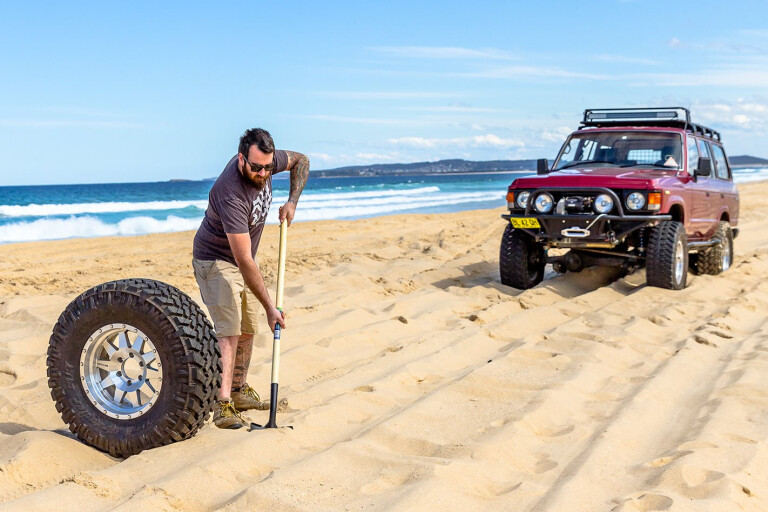
THERE’S a lot to be said about using punishment for learning.
A quick bop on the nose teaches your dog to stop sniffing around the barbecue, a hefty fine in the mail teaches us not to speed, or, in extreme cases, an overnight stay in the clink lets us know Mr. Plod thinks we should have a few less beers next time we’re in Kings Cross.
Following that same logic, this next recovery technique is a surefire way to teach you never to get stuck again because the punishment far outweighs the crime.
So, there you are, trundling along the beach by yourself on a week day. You’ve forgotten the MaxTrax, the exhaust jack is sitting on the shelf, and you neglected to back off the loud pedal before sinking axle deep in the soft stuff.
With no one in sight and no trees to speak of, you’re left with one option: bury your spare tyre and use it as an anchor. This will be a lesson in preparedness you won’t soon forget.
STEPS
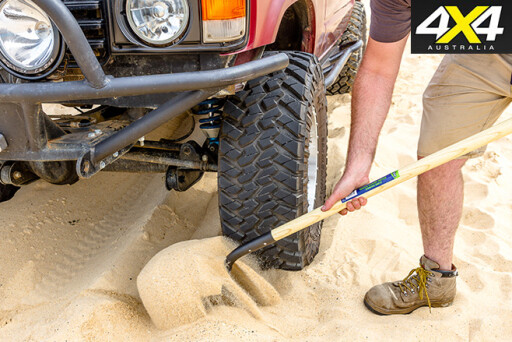 1. NO CHOICE
1. NO CHOICE
THIS might sound a little backwards, but the first step when it looks like you’ll have to bury your spare tyre is to try every other conceivable method of getting yourself un-stuck. It’s a seriously last-resort option that involves hard yakka and a long time in the sun. If you’ve got a shovel – and you should always have a shovel – try using it to dig away the sand from in front of your tyres.
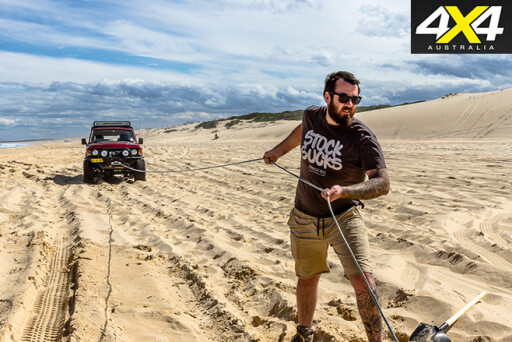 2. ROPE-A-DOPE
2. ROPE-A-DOPE
IF THAT fails, now isn’t the time to start taking half measures. So wind out the winch rope until there’s just one full layer left on the drum. It’ll let your winch work with its maximum pulling potential and, hopefully, give you enough length to get back on semi-solid ground.
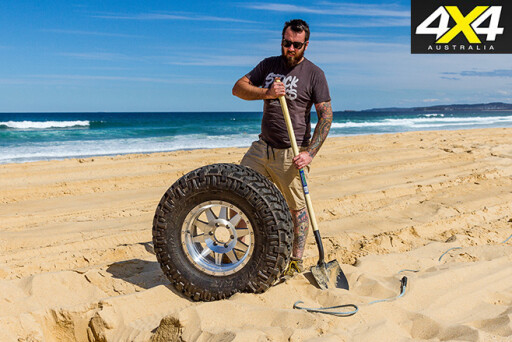 3. DIGGITY
3. DIGGITY
NOW grab your trusty long-handled shovel. You’ll need to dig the hole deep enough to get your spare tyre completely under the surface, with at least 100mm of room to pack sand above again. As difficult as it is, you’ll need to avoid sloping the side of the hole closest to your vehicle, as it’s going to bear the full force of the spare tyre pushing against it. If possible, undercut the hole so the tyre is leaning away from the vehicle. Don’t cart the sand too far away either, as you’ll need it again soon.
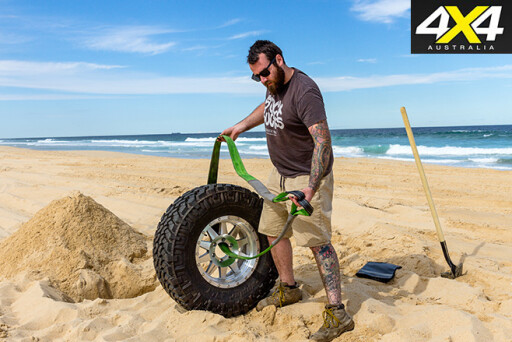 4. FILL THE HOLE
4. FILL THE HOLE
BY NOW the sun should be about an hour lower in the sky, and you’ll be cursing yourself for driving on that damned beach. But the good news is it’s now time to fill the hole. Grab your spare tyre and feed a tree-trunk protector through the centre hole of your wheel and back over the front. Avoid putting the strap through any spokes in your wheel, as the load can buckle steel and alloy wheels alike.
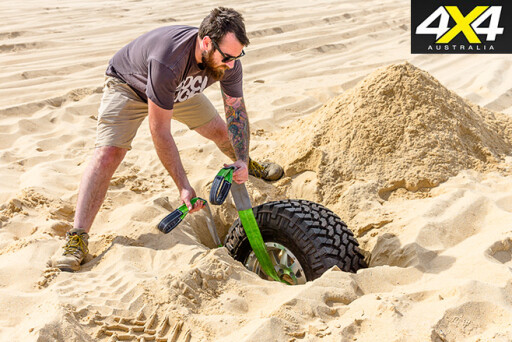 5. WHEEL IT IN
5. WHEEL IT IN
ROLL the tyre to the edge of the hole and gently lower it in. If you have a standard size tyre you should be able to lower it in by hand, being careful not to push sand back in the hole. You’ll need to face the outside of your wheel against the front edge of the hole. It has a bigger surface area so can spread the load over a larger area. If you have larger and heavier tyres you’ll need to roll the tyre in from the side. The strap should be at the bottom of the tyre, if possible.
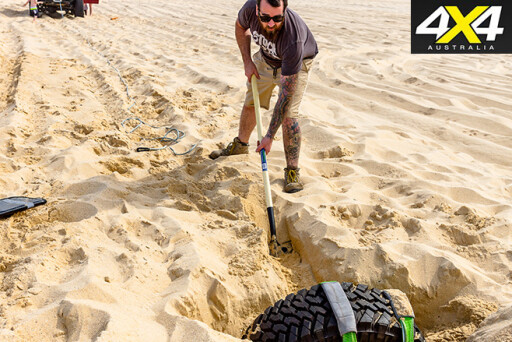 6. MORE DIGGING
6. MORE DIGGING
DON’T get too excited just yet – there’s more digging to be done. You must now dig a shallow trench through the sand so your winch line can make a beeline to the ends of your tree-trunk protector in the wheel. Try and keep the trench as narrow as possible, as the more sand you take away the less strength the wall of the hole will have to hold your spare tyre.
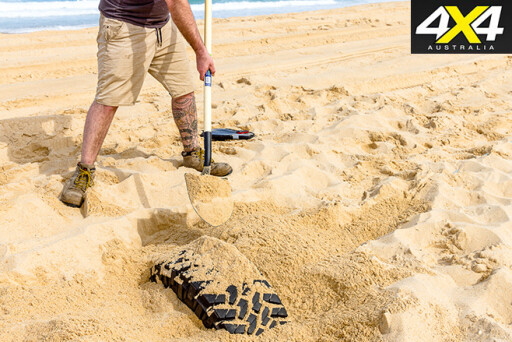 7. PACK IT IN
7. PACK IT IN
GRAB your shovel again and get back to work. As backwards as it sounds, you’ll want to pack as much loose sand as possible behind the wheel first – the idea being to keep the spare tyre pushed against the hole’s still firm front sidewall. As you shovel the sand in, push it down into place. The tighter packed the sand, the less chance your spare tyre will pop out before you do.
 8. RECOVERY KIT
8. RECOVERY KIT
WITH the spare tyre properly buried and your tree-trunk protector poking into the trench, grab your recovery kit and rig it up. If you’re using a hook, keep its open end up, so it shoots down if it breaks. You’ll also need to fit a winch blanket; although, it should be halfway between your vehicle, just where your line enters the sand. Avoid handling straps and rope while they’re covered in sand, as the abrasive particles can work their way into the webbing and cut it to pieces over time from the inside-out.
 9. GIVE IT A WHIRL
9. GIVE IT A WHIRL
WITH passengers and eager spectators standing well clear, jump back in your 4x4 and pull the winch-line tight. The spare tyre should be deep enough to pull you out but won’t stand a chance against the dead weight of a fully loaded 4x4, so give it all the help you can. Make sure there’s as much sand cleared away from in front of your tyres as possible and, in first gear low range, drive with the winch without spinning your tyres.
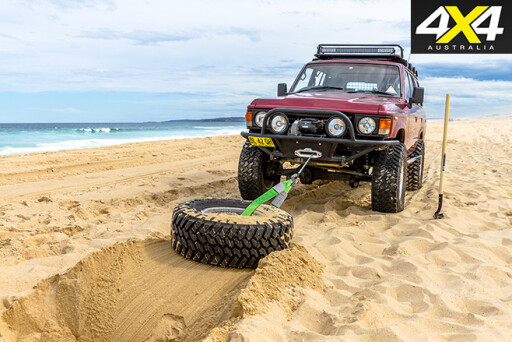 10. CLEAN THE MESS
10. CLEAN THE MESS
WHEN you’re back on solid ground, it’s time to reach for the shovel one last time. Before you disconnect your winch line, drive over the top of the hole and winch in. The spare tyre should have no problems pulling up through the recently disturbed sand. It’ll leave a mud-tyre-sized hole that could catch out unsuspecting beachgoers, so fill it in before setting off. Don’t forget to thoroughly rinse any recovery gear to remove ingrained sand.

COMMENTS